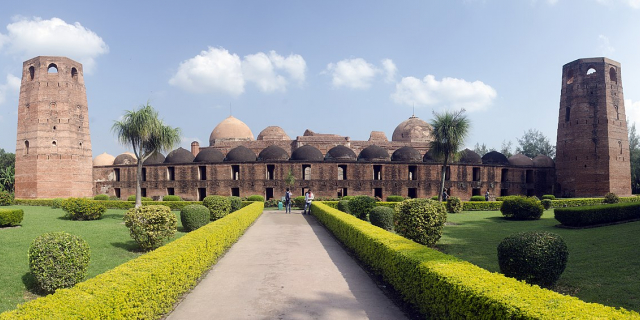Sundarbans
Sundarbans (pronounced ) is a mangrove area in the delta formed by the confluence of the Ganges, Brahmaputra and Meghna Rivers in the Bay of Bengal. Sundarban Reserve Forest (SRF) of Bangladesh is the largest mangrove forest in the world. It spans the area from the Baleswar River in Bangladesh's division of Khulna to the Hooghly River in India's state of West Bengal. It comprises closed and open mangrove forests, land used for agricultural purpose, mudflats and barren land, and is intersected by multiple tidal streams and channels. Sundarbans is home to the world's largest area of mangrove forests. Four protected areas in the Sundarbans are enlisted as UNESCO World Heritage Sites, viz. Sundarbans West (Bangladesh), Sundarbans South (Bangladesh), Sundarbans East (Bangladesh) and Sundarbans National Park (India).
Despite the protected status, the Indian Sundarbans were considered endangered in a 2...Read more
Sundarbans (pronounced ) is a mangrove area in the delta formed by the confluence of the Ganges, Brahmaputra and Meghna Rivers in the Bay of Bengal. Sundarban Reserve Forest (SRF) of Bangladesh is the largest mangrove forest in the world. It spans the area from the Baleswar River in Bangladesh's division of Khulna to the Hooghly River in India's state of West Bengal. It comprises closed and open mangrove forests, land used for agricultural purpose, mudflats and barren land, and is intersected by multiple tidal streams and channels. Sundarbans is home to the world's largest area of mangrove forests. Four protected areas in the Sundarbans are enlisted as UNESCO World Heritage Sites, viz. Sundarbans West (Bangladesh), Sundarbans South (Bangladesh), Sundarbans East (Bangladesh) and Sundarbans National Park (India).
Despite the protected status, the Indian Sundarbans were considered endangered in a 2020 assessment under the IUCN Red List of Ecosystems framework. The Sundarbans mangrove forest covers an area of about 10,000 km2 (3,900 sq mi), of which forests in Bangladesh's Khulna Division extend over 6,517 km2 (2,516 sq mi) and in West Bengal, they extend over 3,483 km2 (1,345 sq mi) across the South 24 Parganas and North 24 Parganas districts. The most abundant tree species are sundri (Heritiera fomes) and gewa (Excoecaria agallocha). The forests provide habitat to 453 fauna wildlife, including 290 bird, 120 fish, 42 mammal, 35 reptile and eight amphibian species. Despite a total ban on all killing or capture of wildlife other than fish and some invertebrates, there has been a consistent pattern of depleted biodiversity or loss of species in the 20th century, with the ecological quality of the forest declining.
Despite preservation commitments from both governments, the Sundarbans are under threat from both natural and human-made causes. In 2007, the landfall of Cyclone Sidr damaged around 40% of the Sundarbans. The forest is also suffering from increased salinity caused by rising sea levels due to climate change and reduced freshwater supply. In May 2009 Cyclone Aila devastated the Sundarbans with massive casualties. At least 100,000 people were affected by this cyclone. The proposed coal-fired Rampal power station situated 14 km (8.7 mi) north of the Sundarbans at Rampal Upazila of Bagerhat District in Khulna, Bangladesh, is anticipated to further damage this unique mangrove forest according to a 2016 report by UNESCO. Climate change is expected to continue to negatively affect both natural systems and human populations in the region, resulting in further ecosystem degradation and climate migration. Experts examining the region recommend further focus on mangrove restoration and management and advocating for adaptation of human populations, through processes like managed retreat and investments in resilient infrastructure.


The history of human settlement in the Sundarbans area can be traced back to Mauryan era (4th-2nd century BCE).[1] A ruin of an abandoned city was found in the Baghmara Forest Block that is attributed to Chand Sadagar, a pre-Mauryan semi-historical figure in Bengali folklore.[2] Archaeological excavation at Kapilmuni, Paikgacha Upazilla, north of the Sundarbans in Bangladesh, revealed ruins of urban settlement dating back to the early middle ages.[3] During the Mughal period, forest tracts were leased out by the local rulers for establishing settlements.[2] In 1757, The British East India Company obtained proprietary rights over Sundarbans from the Mughal Emperor Alamgir II and completed mapping the area in 1764. However, systematic forest management started a century later. The first Forest Management Division to have jurisdiction over the Sundarbans was established in 1869. In 1875 a large portion of the mangrove forests was declared as reserved forests under the Indian Forest Act of 1865 (Act VIII of 1865). The remaining portions of the forests were declared a reserve forest the following year and the forest, which was so far administered by the civil administration district, was placed under the control of the Forest Department. A Forest Division, which is the basic forest management and administration unit, was created in 1879 with the headquarters in Khulna, Bangladesh. The first management plan was written for the period 1893–1898.[4][5]






























Add new comment